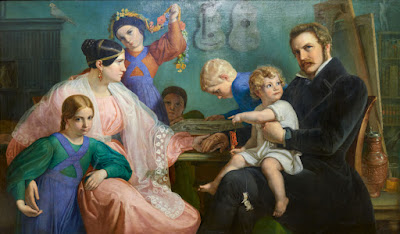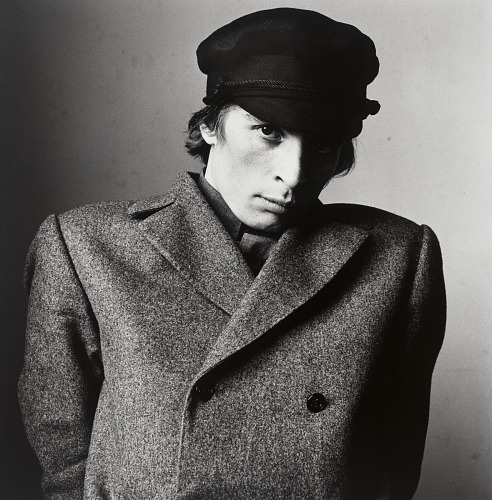 |
| Max Ernst Au Rendez-Vous des Amis 1922 oil on canvas Museum Ludwig, Cologne |
-1653-oil-on-canvas-Herzog-Anton-Ulrich-Museum-Braunschweig.png) |
| Barent Fabritius St Peter in the House of Cornelius (portrait historié of the painter's family) 1653 oil on canvas Herzog Anton Ulrich Museum, Braunschweig |
 |
| Lovis Corinth Die Logenbrüder 1898-99 oil on canvas Lenbachhaus, Munich |
 |
| Johann Gottfried Schadow Eleven Portrait Heads ca. 1800-1803 drawing Kupferstichkabinett,Staatliche Museen zu Berlin |
-Kiruna-1992-C-print-G%C3%B6teborgs-Konstmuseum-Sweden.jpg) |
| Anders Kristensson Truck Drivers, Viscariagruvan, Kiruna 1992 C-print Göteborgs Konstmuseum, Sweden |
 |
| Nils Forsberg Acrobat Family before the Circus Manager 1878 oil on canvas Göteborgs Konstmuseum, Sweden |
 |
| Cornelis de Vos Family Portrait ca. 1617-18 oil on canvas Herzog Anton Ulrich Museum, Braunschweig |
-with-family-of-his-wife-Catharina-van-Noort-(engagement-painting)-c1616-oil-on-canvas-Museumslandschaft-Hessen-Kassel.jpg) |
| Jacob Jordaens Self Portrait (at left, playing lute) with the artist's wife Catharina van Noort and her Family ca. 1616 oil on canvas Museumslandschaft Hessen Kassel |
 |
| R.B. Kitaj Casting 1967 oil on canvas Museum Ludwig, Cologne |
 |
| Abraham van Strij Interior with the Family of Hendrik Weymans 1816 oil on panel Dordrechts Museum |
 |
| Wilhelm Lindenschmit the Elder The Artist with his Family 1836 oil on canvas Landesmuseum, Mainz |
 |
| Peder Severin Krøyer Portrait of arts patron Heinrich Hirschsprung with his Family 1881 oil on canvas Hirschsprung Collection, Copenhagen |
-Dresden.jpg) |
| Gerhard Keil Gymnasts 1939 oil on canvas Galerie Neue Meister (Albertinum), Dresden |
-1817-oil-on-canvas-Mus%C3%A9e-du-Petit-Palais-Paris.jpg) |
| Jean-Auguste-Dominique Ingres Henri IV receiving the Spanish Ambassador 1817 oil on canvas Musée du Petit Palais, Paris |
-at-Palace-Theater-NYC-1963-gelatin-silver-print-Moderna-Museet-Stockholm.jpeg) |
| Louis Faurer Opening of Cleopatra (film) at Palace Theater, NYC 1963 gelatin silver print Moderna Museet, Stockholm |
 |
| Cornelis Bisschop Portrait of the Weinhändlers Family ca. 1670 oil on canvas Museumslandschaft Hessen Kassel |
"He drew out a little pouch that he carried beneath his arm and opened it to reveal a prodigious display of precious stones: pearls the size of small nuts, perfectly spherical and glistening the purest white; emeralds and sapphires, the former as green as grass in springtime, their depths glowing with a luster as clear and soft as olive oil, the latter exactly the color of the sea in the shadow of a tall cliff, sparkling on the surface and a deep violet beneath. In short, all these gems, with their blend of scintillating hues, were a sight to gladden the eye. But one glance was enough."
– Heliodorus, from The Aethiopica, or, Theagenes and Charikleia (3rd or 4th century AD), translated from Greek by J.R. Morgan (1989)






























-c1935-gelatin-silver-print-Moderna-Museet-Stockholm.jpeg)


-Alice-Rohrer-c1930-gelatin-silver-print-New-Mexico-Museum-of-Art-Santa-Fe.jpeg)
-Edward-and-Jo-Hopper-1933-gelatin-silver-print-Whitney-Museum-of-American-Art-New-York.jpeg)
-William-Edmondson-1937-A-gelatin-silver-print-Archives-of-American-Art-Washington-DC.jpg)
-William-Edmondson-1937-B-gelatin-silver-print-Archives-of-American-Art-Washington-DC.jpg)
-Dorothy-Liebes-in-her-Powell-Street-Studio-San-Francisco-1938-gelatin-silver-print-Cooper-Hewitt-Smithsonian-Design-Museum-New-York.jpg)
-Dorothy-Liebes-with-her-Schiaparelli-panel-1938-gelatin-silver-print-Cooper-Hewitt-Smithsonian-Design-Museum-New-York.jpg)
-Bette-Davis-1938-ORIG-gelatin-silver-print-National-Portrait-Gallery-Washington-DC.jpg)
-Carole-Lombard-1938-ORIG-gelatin-silver-print-National-Portrait-Gallery-Washington-DC.jpg)
-Mae-West-1940-ORIG-gelatin-silver-print-National-Portrait-Gallery-Washington-DC.jpg)
-Katharine-Cornell-1941-ORIG-gelatin-silver-print-National-Portrait-Gallery-Washington-DC.jpg)
-Diana-Vreeland-1941-ORIG-gelatin-silver-print-National-Portrait-Gallery-Washington-DC.jpg)
-Spencer-Tracy-1942-ORIG-gelatin-silver-print-National-Portrait-Gallery-Washington-DC.jpg)
-5000-Danish-Seamen-1943-A-photo-lithograph-(poster)-National-Museum-of-American-History-Washington-DC.jpg)
-5000-Danish-Seamen-1943-B-photo-lithograph-(poster)-National-Museum-of-American-History-Washington-DC.jpg)
-Alfred-Lunt-and-Lynn-Fontanne-1946-ORIG-gelatin-silver-print-National-Portrait-Gallery-Washington-DC.jpg)
-Portrait-of-a-Woman-c1948-gelatin-silver-print-Hirshhorn-Museum-Washington-DC.jpg)